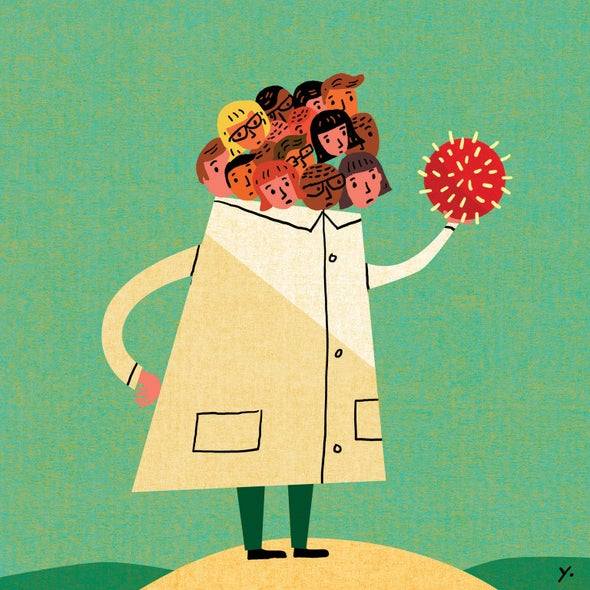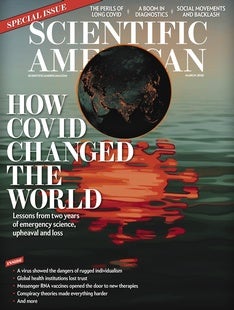Most of the time science is a slow and tedious business. Researchers toil away for decades at obscure limits of human knowledge, collecting and analyzing data, refining theories, writing, debating, and advancing our understanding of the world in tiny increments. Working in small teams on highly specialized projects far from the public eye—that is what most of us are accustomed to doing.
But a calamity upends everything. In early 2020 COVID spread around the globe. Millions of lives were at stake. Yet we knew next to nothing about the nature of the threat. Just a few months earlier no one had ever seen the SARS-CoV-2 virus.
For researchers, the emergence of the disease was an all-hands-on-deck moment. Biologists such as the two of us, along with virologists and immunologists, all pivoted to focus on the new pathogen. And other researchers from across the scientific ecosystem—economists, physicists, engineers, statisticians, psychologists, sociologists, and more—dropped everything to learn about COVID and figure out how they could contribute. Public interest exploded. Scientists with scant experience in public communication learned to work closely with journalists, informing a worried public about what was happening, what to expect next and what people could do to keep themselves safe. The scale of cooperation and collaboration is staggering. Large-scale surveys of scientists done in 2020 and 2021 show that roughly a third of researchers in the U.S. and Europe contributed to the effort.
This vast collaboration moved quickly and effectively in several areas. On December 30, 2019, an epidemiological surveillance network published the first English-language note about a cluster of pneumonia cases of unknown cause in Wuhan, China. Eight days later Chinese scientists identified the pathogen as a novel coronavirus. The full genome sequence was published just two days after that. Then on January 13, 2020, the World Health Organization published instructions for a PCR-based diagnostic test based on that genome.

The genome sequence also opened the door for vaccine development. Scientists used it to determine the 3-D structure of the SARS-CoV-2 spike protein, and by the end of January they had figured out how to stabilize the protein to make it an effective vaccine component, leading to mRNA-based and other vaccines, which were developed, tested and distributed in less than a year.
The urgency of COVID drove scientists to adapt. Discussions that previously took place at conferences, on the telephone or in revision notes on manuscripts moved to social media platforms such as Twitter, review sites such as PubPeer and all-hours Zoom rooms. Researchers and clinicians spontaneously organized into focused teams and working groups. By rapidly sharing information on their patients, physicians figured out that people with severe COVID were at high risk for dangerous blood clots in their lungs, so anticoagulants became a standard of care and saved lives.
In general, traditional modes of publication were far too slow. We embraced a rapid alternative model: preprint archives, where papers are posted prior to peer review or consideration at a scientific journal. The number of papers submitted to medRxiv, a key repository of biomedical preprints, increased 10-fold in the first few months of the pandemic.
These changes also shifted early-stage science from a private activity to part of the public discourse. Instead of presenting the world with polished scientific articles, investigators worked in open view, thinking aloud, offering preliminary speculations, arguing, making wrong turns, following dead ends and pursuing some hypotheses that would ultimately be refuted.
This approach to communication does have a downside. Previously private communications were now open to exploitation and distortion by politicians and pundits. For instance, flawed blood-sample research reported in an April 2020 medRxiv paper purported to show that COVID was a mild disease with a very low fatality rate. Although the scientific community quickly pointed out a host of problems with the work, people seeking to avoid business restrictions, school closures and mask mandates ignored the criticism and used the paper to undermine public health interventions.
Rapid and unorthodox channels of communication also could not solve all the problems scientists encountered. We took too long to recognize the importance of airborne transmission of the virus. We spent early 2020 washing our groceries but not wearing masks. Most critically, we have been largely unsuccessful at anticipating and managing the human element of the pandemic. By not accounting for ways that behavior would change in response to information—and misinformation—we have struggled to predict the size and timing of successive disease waves and virus variants. A collective failure to stop misinformation from spreading on social and traditional media platforms has left large segments of the population unvaccinated, vulnerable and unwilling to embrace measures such as masks and social distancing.
By some measures COVID has also hampered scientific productivity overall, researchers suggested in a paper in Nature Communications late last year. Some of the 2020 survey data revealed that scientists were spending an average of seven fewer hours per week working on research. The group, led by Dashun Wang of Northwestern University, wrote that the decrease in productivity will likely have lasting effects, with scientists reporting fewer publications, collaborations, submitted papers and new projects started during the pandemic. Lockdowns, school closures and other changes took a disproportionate toll on women scientists juggling work and child care—a major problem that requires urgent redress.
But a publication dip is precisely what we would expect when scientists shift from day-to-day research to an emergency response. Placing papers in journals becomes secondary to fixing problems. Dealing with urgent issues is one of the most important roles of the publicly funded scientific ecosystem, which has millions of researchers effectively on retainer. When global crises arise, they organize, learn and coordinate. And that, ultimately, leads to solutions.


